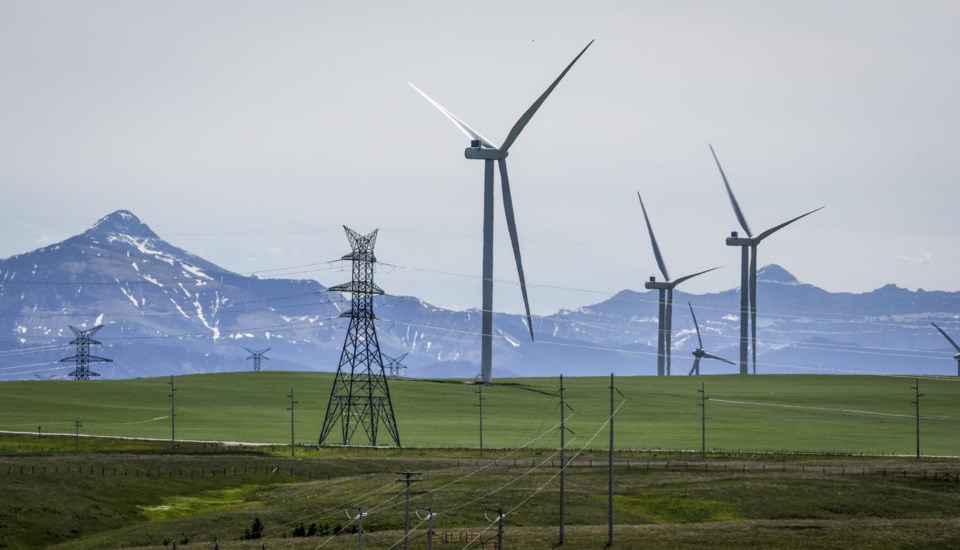CALGARY — A report says new cleanup rules for renewable energy sites are hurting the competitiveness of Alberta's industry.
Business Renewables Centre-Canada analyzed the reclamation security requirements for renewables in 27 jurisdictions and found Alberta's are now the most costly.
Under a code of practice for solar and wind projects published last week, the Alberta government says operators must provide an estimate for the cost of dismantling turbines and panels, removing underground concrete infrastructure, hauling waste away, replanting vegetation and other items.
A 30-per-cent security is required upfront, rising to 60 per cent after 15 years to ensure there is enough money for proper cleanup at the sites' end of life.
BRC-Canada says Alberta's upfront security requirement is unusually high and the rules don't take into account the salvage value of the concrete and metals that could be sold to recoup cleanup expenses.
The Alberta government issued the new rules in February 2024, just as a seven-month moratorium on new renewable project approvals expired, but it had yet to lay out the details around how they'd be implemented.
Jorden Dye, BRC-Canada's director, said many renewable projects are being built by multinational companies that can move their capital around easily.
"And it'll just be really disappointing if we see Alberta lose out and lose our ground as the biggest developer of renewable energy in the last few years in Canada because we've continued to place onerous rules on the industry," he said.
In addition to the reclamation security requirements, the province has placed buffer zones around wind turbines so as not to impede "pristine viewpoints" and is taking an "agriculture first" approach to deciding what can be built on farmland. The province is also working through consultations on the structure of its energy market as well as transmission regulations.
"If you take one by itself, it's OK — we might be able to live with it, or we can work around it," said Dye.
"It's kind of getting to the totality of the decisions that's really driving some of the concerns."
The BRC-Canada study noted some jurisdictions — such Illinois and Tennessee — require a 100-per-cent reclamation security, but only 10 per cent of that must be paid upfront.
"Renewable energy projects are really sensitive to the upfront capital cost," Dye said. "Having that as an operating annual cost is a lot different to whether a project will go forward than if it's an upfront cost."
Three-quarters of the jurisdictions the group compared accounted for the salvage value of materials once projects are dismantled. While that amount may not reflect the real-world value of the metal and concrete decades into the future, it does go a long way toward offsetting the reclamation costs, Dye said.
Dye said wind and solar projects generally have a lifespan of 20 to 50 years, but components are often refurbished along the way. And when they're done operating, there is decades' worth of real-world data to make pursuing another development easier.
While an oil or gas well will eventually become depleted, "the sun and the wind will still be there in those exact spots," Dye said.
The cost of cleaning up old oil and gas wells has been a major issue in the oil and gas sector. The Alberta Energy Regulator estimates that as of June 2024, there were $36 billion in environmental liabilities.
In announcing the renewables policy in February 2024, Alberta Premier Danielle Smith said the province was looking for a different and better way to approach solar and wind cleanup than what had been done for oil and gas.
"It is critical that we do not repeat errors of the past, and that we have reclamation rules and costs accounted for at the beginning of any development," she said. The reclamation bond or security can be paid to the Alberta government, or be negotiated between the renewable developer and a landowner.
Janetta McKenzie, oil and gas program director at the Pembina Institute think-tank, said the rules for wind and solar are fundamentally different than "generous and flexible" ones for oil and gas.
In that sector, companies are required to pay about one per cent of cleanup costs in upfront securities, with no firm timelines, she said.
The industry-funded Orphan Well Association looks after closure costs when an energy company has gone bankrupt or otherwise cannot meet its obligations. But that organization "is also buttressed by some interest-free loans from the provincial and federal government and is pretty persistently underfunded," McKenzie said.
"This is a province that wants to unleash its energy sector, but there is an energy sector that's waiting for a stable regulatory environment and then one that is being given a lot of options to not reclaim and not clean up itself in a timely manner."
This report by The Canadian Press was first published June 10, 2025.
Lauren Krugel, The Canadian Press



